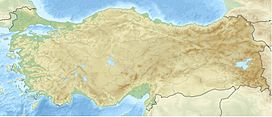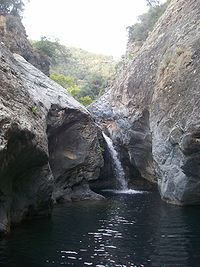- Mount Ida (Turkey)
-
Kazdağı, Turkey 
Location of Kaz Daği on a map of the ancient TroadElevation 5,820 ft (1,774 m) Prominence At Karataş peak (ancient Gargarus) Location Balıkesir Province, Northwest Turkey Coordinates 39°42′N 26°50′E / 39.7°N 26.833°ECoordinates: 39°42′N 26°50′E / 39.7°N 26.833°E Mount Ida (Turkish: Kazdağı, pronounced [kazdaːɯ], meaning "Goose Mountain",[1] Kaz Dağları, or Karataş Tepesi) is a mountain in northwestern Turkey, southeast of the ruins of Troy, along the north coast of the Gulf of Edremit. The name Mount Ida is the ancient one. It is between Balıkesir Province and Çanakkale Province
Contents
Geography
Mount Ida is lightly populated upland massif of about 700 km² located to the north of Edremit. A number of small villages in the region are connected by paths. Drainage is mainly to the south, into the Gulf of Edremit, also known as Edremit Bay, where the coast is rugged and is known as "the Olive Riviera.". However, the Karamenderes River (the ancient Scamander) flows from the other side of Mount Ida to the west. Its valley under Kaz Dağları has been called "the Vale of Troy" by English speakers.[2] Currently a modest 2.4 km² of Mount Ida are protected by Kaz Dağı National Park, created in 1993.
The summit is windswept and bare with a relatively low tree line due to exposure, but the slopes of this mountain, at the edge of mild Mediterranean and colder central Anatolian climate zones, hold a wealth of endemic flora, marooned here after the Ice Age. The climate at lower altitudes has become increasingly hot and dry in the deforested landscape. The dry period lasts from May to October. Rainfall averages between 631 and 733 mm per year. The mean annual temperature is 15.7 degrees Celsius, with diurnal temperatures as high as 43.7 degrees Celsius in Edremit. The forests on the upper slopes consist mainly of Turkish Fir (Abies nordmanniana subsp. equi-trojani; considered by some botanists to be a distinct species Abies equi-trojani).
Legend
Cultic significance
Cybele
In ancient times, the mountain was dedicated to the worship of Cybele, who at Rome therefore was given the epithet Idaea Mater.
Sibylline books
The oldest collection of Sibylline utterances, the Sibylline books, appears to have been made about the time of Cyrus at Gergis on Mount Ida; it was attributed to the Hellespontine Sibyl and was preserved in the temple of Apollo at Gergis. From Gergis the collection passed to Erythrae, where it became famous as the oracles of the Erythraean Sibyl. It seems to have been this very collection, or so it would appear, which found its way to Cumae (see the Cumaean Sibyl) and from Cumae to Rome.
Mythology
Idaea
Idaea was a nymph, mate of the river god Scamander, and mother of King Teucer the Trojan king. The Scamander River flowed from Mount Ida across the plain beneath the city of Troy, and joined the Hellespont north of the city.
Ganymede
At an earlier time, on Mount Ida, Ganymede, the son of Tros or perhaps of Laomedon, both kings of Troy, was desired by Zeus, who descended in the form of an eagle and swept up Ganymede, to be cupbearer to the Olympian gods.
Paris
On the sacred mountain, the nymphs who were the daughter-spirits of the river Cebrenus, had their haunt, and one, Oenone, who had the chthonic gifts of prophetic vision and the curative powers of herb magic, wed Paris, living as a shepherd on Mount Ida. Unbeknownst to all, even to himself, Paris was the son of Priam, king of Troy. He was there on Mount Ida, experiencing the rustic education in exile of many heroes of Greek mythology, for his disastrous future effect on Troy was foretold at his birth, and Priam had him exposed on the sacred slopes. When the good shepherd who was entrusted with the baby returned to bury the exposed child, he discovered that he had been suckled by a she-bear (a totem animal of the archaic goddess Artemis) and took the child home to be foster-nursed by his wife.
When Eris ("discord") cast the Apple of Discord, inscribed "for the fairest", into the wedding festivities of Peleus with Thetis, three great goddesses repaired to Mount Ida to be appraised. By a sacred spring on the mountainside, in "the Judgment of Paris", the grown youth Paris awarded it to Aphrodite, who offered Helen for a bribe, earning the perpetual enmity of the discredited goddesses Hera and Athena to the Trojan cause (Apollodorus, 3:12.5).
Anchises
Anchises, father of Aeneas, also of the Trojan royal house, was tending sheep on Mount Ida when he was seduced by Aphrodite. Their union led to the birth of Aeneas, the mythological progenitor of Rome's Julio-Claudian dynasty and a founder of Rome in a tradition alternative to that of Romulus and Remus.
Trojan War
The mountain is the scene of several mythic events in the works of Homer. At its summit, the Olympian gods gathered to watch the progress of the epic fight. But the mountain was the sacred place of the Goddess, and Hera's powers were so magnified on Mount Ida, that she was able to distract Zeus with her seductions, just long enough to permit Poseidon to intercede on behalf of the Argives to drive Hektor and the Trojans back from the ships.
During the Trojan War, in an episode recorded in Apollodorus's Epitome, Achilles with some of the Achaean chiefs laid waste the countryside, and made his way to Ida to rustle the cattle of Aeneas. But Aeneas fled, and Achilles killed the cowherds and Mestor, son of Priam, and drove away the sacred kine (Epitome 3.32). Achilles briefly refers to this incident as he prepares to duel with Aeneas during the siege of Troy. (Iliad XX)
After the Trojan War, the only surviving son of Priam, Helenus, retired to Mount Ida, where he was surprised and became the captive of Neoptolemus. In the Aeneid a shooting star falls onto the mountain in answer to the prayer of Anchises to Jupiter.
History
Bronze age
In the Bronze Age, the region around the mountain complex had a somewhat checquered ethnography. There is evidence for the following peoples with a reasonable degree of probability:
- The Tjeker in Ayvacık, Çanakkale Province, which the Greeks called the Teucri. They were probably from Crete and are most likely to have been the source of the name, Mount Ida, which they took from Mount Ida, Crete.
Iron age
In historical times, Xerxes I' march took him past Mount Ida (Herodotus VII:42).
See also
Notes
- ^ This etymology is given by Tanıtkan in the article referenced by the link below.
- ^ A term from the play, Friar Bacon, Line 412, by the Elizabethan playwright, Robert Greene, 1560-1592. This information comes from an untitled book review by Robert Adger Law in Modern Language Notes, Vol. 22, No. 6 (Jun., 1907), pp. 197-199
References
- Martyn Rix, "Wild About Ida: the glorious flora of Kaz Dagi and the Vale of Troy", Cornucopia 26, 2002.
External links
- Live Search gives a clickable 2-D or 3-D map of the region based on aerial photography.
- Kaz Dağı: The magic mountain, article by Recep Peker Tanıtkan in Diplomat magazine, Ankara, May, 2006.
- Morphological, Anatomical and Ecological studies on the two Turkish endemic species collected from Kaz Dağı (B1 Balıkesir) “Allium sibthorpianum Schultes & Schultes fil. and Allium reuterianum Boiss.”, article by İsmet Uysal in the Turkish Journal of Journal of Botany, 23 (1999), 137–148.
- A Contribution to the Moss Flora of Western Turkey: Moss Flora of the Kaz Mountain (Balıkesir, Turkey), article by Adnan Erdag and Ahmet Yayıntaş in the Turkish Journal of Botany, 23 (1999), 117–125.
National parks of Turkey Aegean Region Black Sea Region Alacahöyük · Altındere · Hatila Valley · Kaçkar Mountains · Karagöl-Sahara · Küre Mountains · Mount Ilgaz · YedigöllerCentral Anatolia Region Eastern Anatolia Region Marmara Region Mediterranean Region Altınbeşik Cave · Beydağları Coast (Olympos) · Güllük Mountain (Termessos) · Karatepe-Aslantaş · Kızıldağ · Köprülü Canyon · Lake Kovada · Saklıkent CanyonSoutheastern Anatolia Region Categories:- Mountains of Turkey
- Geography of ancient Anatolia
- National parks of Turkey
- Balıkesir Province
- Locations in the Iliad
Wikimedia Foundation. 2010.


